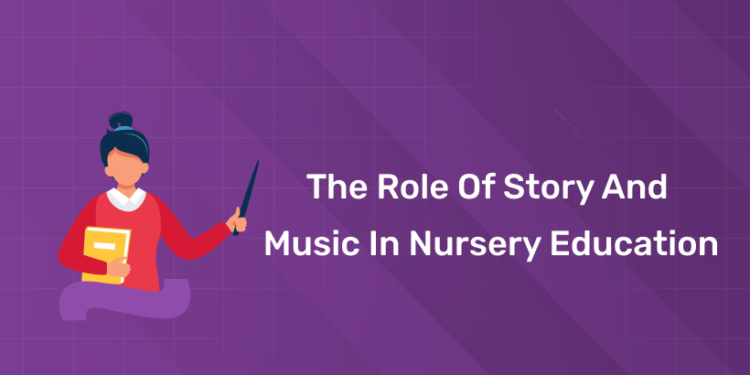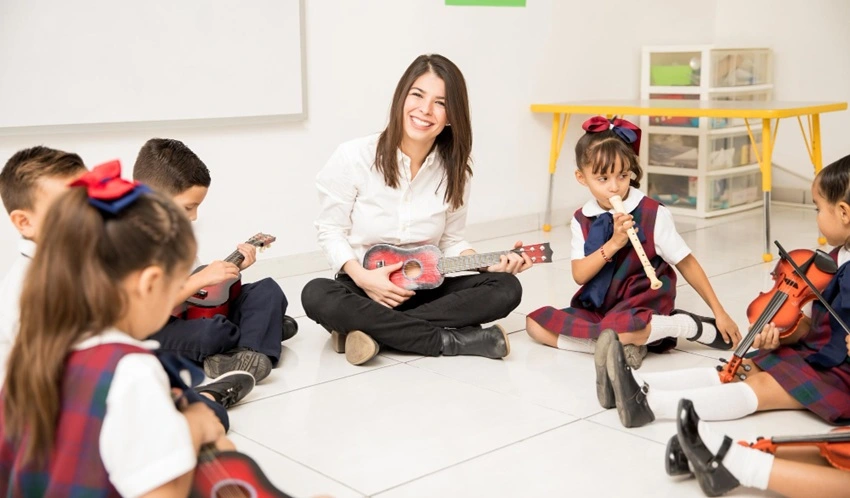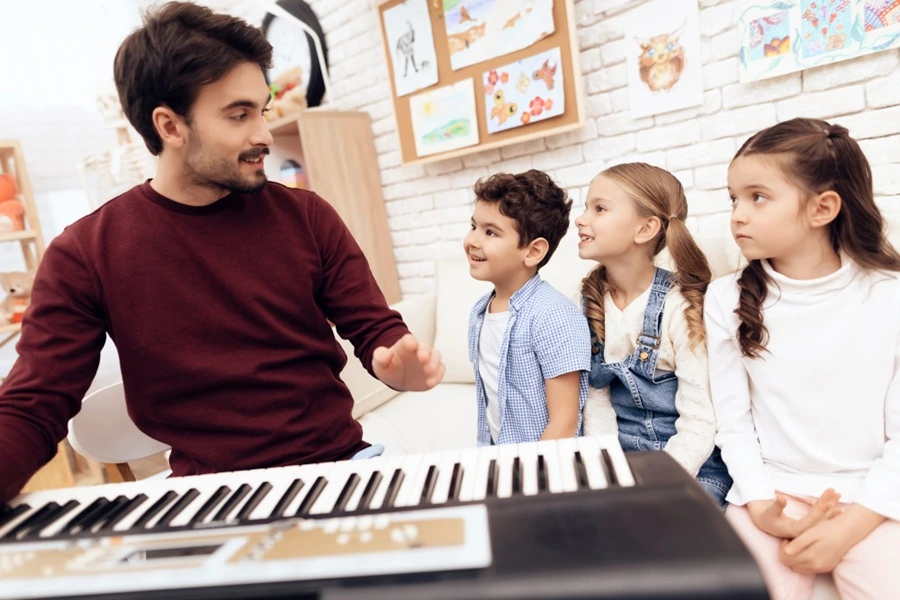Table of Contents
Walk into any good nursery or Montessori school in India and you’ll see the same scene again and again:
- A group of children sitting in a circle
- A teacher with a picture book or a puppet, telling a story
- Little voices singing rhymes with actions – clapping, jumping, swaying
It can look like “just fun”, but for children between 2 and 6 years, story and music are actually doing serious developmental work in the background.
Research shows that storytelling in early childhood strengthens language, vocabulary, comprehension, imagination, empathy, and social skills.
Music and nursery rhymes help build phonological awareness (the ability to hear and play with sounds in words), which is a key predictor of later reading success.
For aspiring teachers – especially those considering Montessori teaching – understanding how to use story and music well is a real superpower. It’s what transforms a basic classroom into a rich, child-centred learning environment.
Register for the Entri Elevate Montessori Teacher Training Program! Click here to join!
The Nursery Years: A Powerful Window for Story & Music
From birth to around 6 years, the brain is in “high-speed construction mode”. Early childhood experts note that rich language and sensory experiences during this time strongly influence:
- Language development
- Thinking and problem-solving
- Emotional understanding
- Social skills and behaviour
Why story fits this stage so well
Studies on storytelling in preschool show that regular story sessions:
- Expand vocabulary and grammar
- Improve listening and attention span
- Strengthen comprehension and narrative skills
- Build empathy by helping children see the world from another person’s point of view
Why music fits this stage so well
Research on early literacy and music finds that songs and rhymes:
- Boost phonological awareness – hearing rhymes, syllables and sounds
- Improve memory and pattern recognition
- Support coordination and motor skills when actions are added
- Make transitions and routines smoother (clean-up songs, snack-time songs, etc.)
In simple words: story feeds the mind; music feeds both mind and body. Together, they create a rich learning environment for young children.
The Role of Story in Nursery Education
1: What is the primary focus of the first plane of development in the Montessori method?
Language and cognitive development
Storytime isn’t just entertainment. It’s a language workout.
When children listen to stories, they are exposed to:
- New words and phrases that don’t appear in everyday small talk
- Different sentence structures and tenses
- Complex ideas like “because”, “before”, “after”, “if”
Studies show that storytelling improves vocabulary, grammar, comprehension and narrative skills – all crucial for later reading and writing.
For example, a simple story about “a lost kite” can introduce:
- Emotions (sad, worried, hopeful)
- Time words (yesterday, later, after school)
- Problem–solution thinking (What can we do? Who can help?)
Emotional understanding and empathy
Good stories are full of feelings and conflicts – perfect for helping nursery-age children learn to name and handle emotions.
Research from early childhood centres highlights how storytelling builds emotional intelligence, empathy and social understanding by letting children “step into” a character’s experience.
For example:
- A story about a child who doesn’t want to share a toy
- A story about being scared on the first day of school
- A story about losing a pet or favourite object
After the story, a teacher can gently ask:
- “How do you think she felt?”
- “Have you ever felt like that?”
- “What helped in the story?”
This helps children connect their inner world with words and actions.
Values, culture, and identity
In India, storytelling is a natural way to pass on:
- Local culture and festivals
- Moral values like kindness, honesty, and respect
- Community stories from different states, religions, and languages
Montessori-inspired schools and many nurseries consciously choose stories that reflect diverse families and backgrounds so every child feels represented.
For aspiring teachers, especially those working in multilingual or multicultural settings, story becomes a tool to say:
“Your language and your family’s stories belong here.”
Get Certified & Start Your Montessori Career
Montessori Teacher Training Course by Entri App: Gain expert skills, earn certification, and kickstart your teaching career.
Join Now!The Role of Music and Nursery Rhymes in Nursery Education
Building the foundations of reading
One of the strongest research findings in early childhood is the link between nursery rhymes and later reading success.
Studies on phonological awareness show that children who play with rhymes, rhythms and sounds in preschool:
- Are better at hearing and manipulating sounds in words (e.g., bat–cat, sun–fun)
- Develop stronger phonemic awareness – a crucial pre-reading skill
- Tend to become more confident readers later in primary school
Songs and rhymes often have:
- Repetition (“Johny Johny yes papa…”)
- Predictable patterns (A–B–A structure in verses)
- Strong rhythm (easy to clap or tap along)
All these elements train the ear and brain to notice patterns in language, which is exactly what reading and spelling require.
Cognitive, social, and motor benefits
Music in early childhood has been linked to:
- Better attention and memory
- Improved coordination and timing (through clapping, marching, dancing)
- Social bonding when children sing and move together
- Increased self-confidence when a child leads a song or keeps the beat
Many Montessori and nursery classrooms use:
- Welcome songs – to build a sense of community
- Clean-up songs – to make tidying fun and predictable
- Quiet songs or instrumental music – to calm the atmosphere after high-energy play
Cultural connection through music
Music is also a powerful carrier of culture.
Montessori writers and practitioners note that music and songs in the classroom introduce children to:
- Traditional rhymes and lullabies
- Songs from different countries and languages
- Ideas about nature, seasons, continents and peace
In Indian settings, this may include:
- Regional lullabies (Malayalam, Tamil, Hindi, Bengali, etc.)
- Festival songs (Onam, Diwali, Christmas, Eid)
- Simple bhajans or devotional songs in inclusive, age-appropriate ways
For children, this isn’t “culture lesson time” – it’s just joyful singing and moving. But over time, it quietly builds pride and respect for diversity.
How Montessori Education Naturally Uses Story and Music
Montessori education sees the child as a whole person – mind, body, emotions and spirit. Story and music fit beautifully into this approach.
Storytelling in Montessori settings
In Montessori classrooms, storytelling may appear as:
- Picture talks and classified cards – where the teacher introduces vocabulary through simple stories about animals, plants, community helpers, festivals, etc.
- Cosmic stories and cultural stories – to introduce children to the wider world, time, nature and different cultures.
The goals are to:
- Nurture curiosity and imagination
- Connect abstract concepts (time, change, responsibility) with concrete stories
- Encourage children to retell or act out stories using materials
Music the Montessori way
The Montessori approach to music emphasises experience through the senses. Dr. Maria Montessori worked with musicians to create a program where children:
- Listen carefully to sounds and silence
- Explore pitch, rhythm and dynamics through hands-on activities
- Use simple instruments and movement to feel music in the body
Montessori music is not about pushing children into performance; it’s about:
- Developing listening skills and concentration
- Refining the ear for pitch and rhythm
- Offering music as another language of expression
Every day practice might include:
- Soft background music during certain work periods
- Group singing of rhymes and cultural songs
- Sensorial games that sort sounds (loud/soft, high/low, fast/slow)
For aspiring Montessori teachers, understanding this philosophy helps you use music intentionally, not just as time-passing.
Practical Ideas for Teachers & Parents
You don’t need an expensive set-up to make story and music central in nursery education. Here are simple, India-friendly ideas.
Building a rich story routine
- Daily story circle (10–15 minutes)
- Same time every day – children love predictability.
- Rotate between picture books, folk tales, and simple moral stories.
- Interactive storytelling
- Ask children to guess what happens next.
- Let them repeat key lines or sounds (“knock knock”, “splash”, “roar”).
- Use puppets or simple props made from paper and cloth.
- Retelling and drawing
- After the story, invite children to draw their favourite part.
- Ask, “Who can tell me the story in your own words?”
- This strengthens comprehension and speaking skills.
- Use local languages
- Mix English with the child’s home language (Malayalam, Tamil, Hindi, etc.).
- Tell the same simple story in more than one language if possible – this supports multilingual development and inclusivity.
Weaving music into the whole day
- Welcome and goodbye songs
- Simple tunes with the children’s names:
“Good morning, Aisha, good morning, Rohan…”
- Builds belonging and routine.
- Simple tunes with the children’s names:
- Transition songs
- Short chants for lining up, washing hands, cleaning up.
- Example: “Clean up, clean up, 1–2–3, let’s keep our room as neat as can be.”
- Action rhymes
- Use rhymes with clapping, jumping, tip-toeing.
- This supports phonological awareness, listening and motor skills.
- Quiet music moments
- Soft instrumental music or humming after playtime or lunch.
- Help children notice how music can calm the body and mind.
Low-cost, Indian-context ideas
- Collect folk tales and rhymes from families – ask grandparents and parents to share.
- Create a “story box” with simple objects (shell, leaf, toy animal) and invite children to make up stories.
- Use simple instruments: steel plates and spoons, shakers filled with rice, clapping patterns – not everything has to be store-bought.
Get Certified & Start Your Montessori Career
Montessori Teacher Training Course by Entri App: Gain expert skills, earn certification, and kickstart your teaching career.
Join Now!How Entri’s Montessori TTC Course Supports Aspiring Teachers
If you want to move from “I love children” to “I am a trained early childhood educator”, structured training makes a huge difference.
Entri offers several Montessori Teacher Training options:
- A comprehensive Montessori Teachers Training Course with live and recorded classes, covering Montessori principles, child psychology, curriculum design, and classroom management.
- A longer PG Diploma in Montessori TTC (9 months) for deeper training and classroom-ready skills.
- A Free Montessori TTC pathway and free workshops to help beginners understand the basics and career opportunities before committing to full programmes.
For aspiring teachers interested in story and music, Entri’s Montessori TTC helps you:
- Understand child development – why stories and music are vital in the 2–6 age group
- Learn how to design Montessori-aligned activities using tales, songs, rhymes, and sensorial materials
- Practise classroom presentation skills – voice modulation, storytelling techniques, group management
- Get guidance on lesson planning, integrating story and music with language, culture, and practical life activities
- Build a career path in Montessori and early childhood education, with placement support in schools and centres that value holistic teaching
In other words, it doesn’t just tell you that story and music are important – it shows you how to use them professionally.
Key Takeaways for Parents & Aspiring Teachers
- Storytelling in the nursery years builds language, vocabulary, comprehension, thinking skills, and empathy. It’s one of the most powerful tools you can use with young children.
- Music and nursery rhymes are not just “time-pass”. They develop phonological awareness, rhythm, coordination, memory, and social bonding – all foundations for later reading and academic success.
- The Montessori method naturally integrates story and music through sensorial experiences, cultural lessons, group singing, and carefully chosen stories that nurture curiosity and respect for diversity.
- You don’t need expensive materials – a warm voice, simple books, local songs, and a bit of creativity are enough to build rich story and music routines.
- If you dream of becoming a Montessori or nursery teacher, Entri’s Montessori TTC programmes provide structured training, expert mentorship, and practical tools to bring story and music into your classroom confidently and professionally.
Final Word
For a young child, a good day is simple:
A loving adult.
A story that sparks imagination.
A song that makes the body move.
A quiet moment to breathe and feel safe.
As a parent or aspiring teacher, when you learn to use story and music with intention, you’re not just “keeping children busy”. You’re building language, literacy, confidence, culture, and joy – one tale and one rhyme at a time.
If you’d like to turn that love for early childhood into a real career, exploring the Entri Montessori TTC course is a natural next step – from learning about story and music to leading powerful, child-centred classrooms that children will remember for life.
Get Certified & Start Your Montessori Career
Montessori Teacher Training Course by Entri App: Gain expert skills, earn certification, and kickstart your teaching career.
Join Now!Frequently Asked Questions
Why are stories important in nursery education?
Stories help children develop imagination, vocabulary, emotional understanding, and listening skills. They create strong foundations for language and literacy.
How does music support early childhood learning?
Music boosts memory, rhythm awareness, emotional regulation, coordination and language development. It also improves focus and classroom transitions.
What type of stories are suitable for nursery children?
Short, repetitive, colourful stories with simple characters work best. Folk tales, animal stories, nature stories and everyday-life stories are ideal.
How can teachers use music in the classroom?
Teachers can use welcome songs, transition songs, movement songs, rhymes, and calming melodies. Music can also support routines and behaviour management.
Can storytelling improve a child’s communication skills?
Yes. Storytelling exposes children to sentence structure, new vocabulary, expressive gestures and turn-taking all essential for communication.
What are some simple music activities for preschoolers?
Clapping games, echo songs, rhythm sticks, action rhymes, marching, and simple dance movements are very effective for nursery-age children.
How does the Montessori approach view stories and music?
Montessori encourages purposeful storytelling, rhythm-based movement, cultural songs and age-appropriate materials to support holistic child development.















